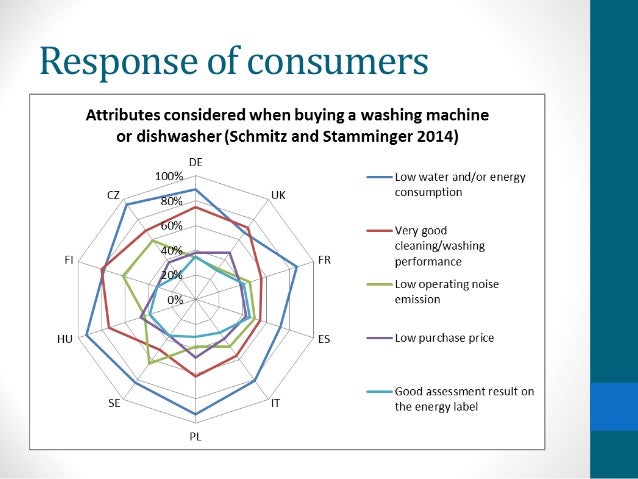The labels were introduced in 1992, the scale was updated in 2010 to add A plus and beyond, then the scale was updated again in 2017 (effective 2021) to go back to A to G. Every ten years or so is probably about as often as a customer needs to replace each appliance, so instead of learning how to interpret the sticker de la décennie they might as well do their own research. If customers don't care about energy use, they will ignore the stickers. And if they do care, the manufacturers can provide that information. One source suggests that customers care about water and energy consumption, but not the energy sticker. "One of the great mistakes is to judge policies and programs by their intentions rather than their results." Here is the sticker-pair that came with the refrigerator we bought. Pass or fail? Will the QR code help the customer compare models? It's just a link to a local-language version of the specs for this model. The same information is already available on the manufacturer's website. Meanwhile, there is an 15,000-word agreement between the EU and the EPA intended to coordinate use of Energy Star stickers in Europe, so the Energy efficiency directive was updated so public bodies' procurement policies would reflect the new guidelines. No, cancel that, the agreement expired in 2018, so Energy Star stickers may no longer be applied and databases and websites and bureaucratic paperwork must be updated again. Are we still saving? This seems like the most reasonable response to the energy stickers.yearly classification cycle seems like an overkill. Decade? That'd be closer to the mark.

There's a QR code on the new ones helping at estimation, or at least that's the intention

I simply don't mind them
Depends on many factors. For my needs? Huge overkill. Doesn't do anything to prove your point or weaken mine. I wonder what you'd say if I supported my claim with some 3rd-rate slideshow originating from a defunct one-person consulting firm. Yes, it sources data of other agencies, but I think neither of us can do more than speculate. You don't like it because it wastes taxes or something, I find it a good shortcut for many people of lackadaisical attitude. Cool. I, too, can drop vaguely related quotes and leave it at that. Observe: "and when men have been educated in such a manner that even the legislator himself cannot trust them, there is real danger." Now, did I mean it literally, in original context, or in context of commentaries of Aristotle's writings? To stop cluttering the other thread, regarding your other comment, this doesn't answer my questions. I didn't mention EnergyStar or who/why/what funds it etc. I inquired the priorities, you read whatever you think you wanted from it.Pass or fail?
source
"One of the great mistakes is to judge policies and programs by their intentions rather than their results."
By "pass or fail" I meant to point out that our appliance scored both A++ and F at the same time, to reiterate the point that what could be a simple and useful guide can be confusing in practice. If you provided evidence of how much people value energy stickers from a 3rd rate slideshow from a defunct one-person consulting firm, I would consider it weak evidence, but better than no evidence. But public opinion is not as important as the real outcomes of the program. The "vaguely related" quote is in response to your statement "at least that's the intention" behind adding QR codes to energy stickers. If the ultimate purpose of the program is to save energy, then we should judge it on how effectively it saves energy, not on intentions. I think Friedman is correct in observing that public programs are often judged by intentions rather than outcomes. Whenever I research a government program, I find gaps between intentions and results. Women, and Infants Children program Intention: "safeguard the health and well-being of the Nation’s children" Result: The program is dominated by three corporations that make infant formula. Subsidized infant formula relieved malnutrition, but also reduces breastfeeding, harming child health. Paid Maternity Leave Intention: "to balance the demands of the workplace with the needs of families, to promote the stability and economic security of families, and to promote national interests in preserving family integrity." Result: A 1% payroll tax is deducted from all California employee income. Some of this is used to replace income for new parents on leave (affluent parents are more likely to participate). Three-quarters of people in low-income groups do not know that the paid leave program exists. Clean Air Act (suggested at my request for "an example of regulation done well") Intention: clean the air Result: The air is cleaner, but costs of the program were enormous, and government authority worked closely with industrial interests for decades to promote and defend leaded gasoline, now recognized as one of the most harmful atmospheric pollutants. Several cities banned lead for health reasons in the 1920s (against the advice of the Surgeon General), but the EPA did not enforce a national ban until the 1970s. As to your questions, I do think it is fine for people to make some effort to find legal ways to save on their taxes, and I also think people shopping for appliances would do well to become informed about energy and water consumption. These activities probably pass a cost-benefit analysis, especially for people who enjoy being informed. As you point out, an hour or two of research can pay off with years of savings. (If you want to prioritize one or the other, I guess it would be the one with the greater expected payoff per hour of research.) I question whether the energy stickers are sufficiently effective in assisting this research to justify the considerable energy used to run the program.